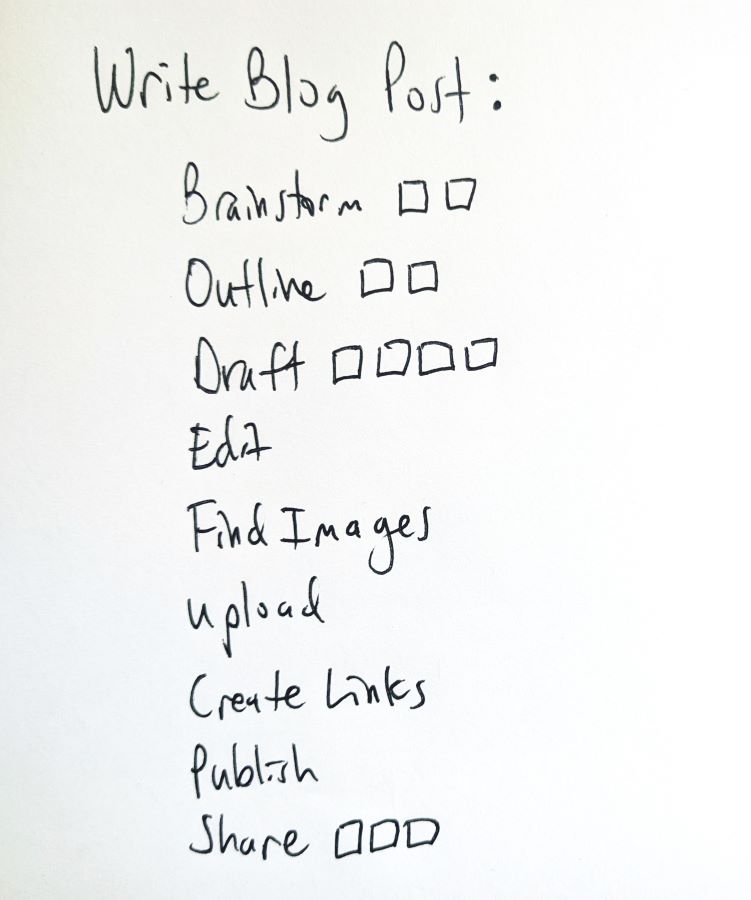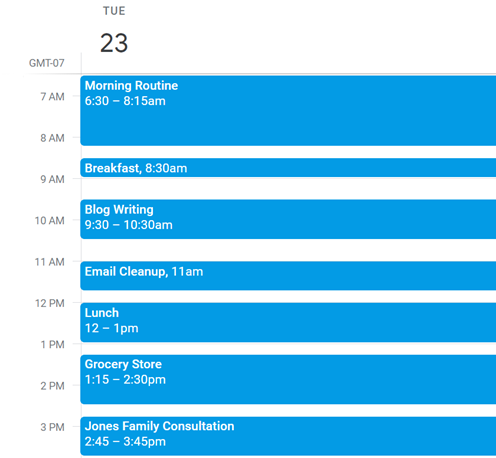
You make what feels like a reasonable to-do list for the day, but then you only get half of it done.
You carefully calculate how early you need to wake up to make it out the door on time, but then you wind up running late anyway.
You tell your guests dinner will be at 6:00, but the food isn’t ready until 7:30.
In each of these cases, you’ve fallen victim to the planning fallacy. Time for a definition:
“The planning fallacy refers to a prediction phenomenon … wherein people underestimate the time it will take to complete a future task.”1
The planning fallacy is a widespread human bias; most people do it.2 So you can quit feeling like something is wrong with you every time you underestimate how long things will take. Humans, it turns out, aren’t very good at time management.
Overcoming the planning fallacy comes in two parts: better planning and ditching shame.
Part 1: Better Planning
Let’s begin with strategies to reduce the impact of the planning fallacy.
Paper To-Do Lists
Just because you can make a digital to-do list with a notes app doesn’t mean you should. The problem with digital to-do lists is that they’re infinite – you can just keep adding things to them.
A paper to-do list doesn’t have that problem. You can only fit so much on the page, so you’re limited to a more reasonable number of tasks. Or I should say less unreasonable because you’ll still put too many things on your paper to-do lists. Luckily, there are strategies to mitigate that tendency:
- Don’t use a full sheet of paper for your lists. Fold the paper in half or into quarters. This makes it harder to put too many things on the list.
- Use a layered to-do list system that separates tasks for today, this week, soon, eventually, and maybe.
- Use to-do list categories that separate tasks into thematic groups such as chores and deep work. To do this, divide the paper you’re using for the list into segments – one for each category. You’ll then be limited to only what you can fit in each box.
- Stop putting things on to-do lists that you don’t really intend to do. (We’ve all done it.) Remember, the signals you send yourself should be meaningful.
- And remember, you don’t have to fill the page. It’s okay, even good, if there is some white space left over.
Break Tasks Into Subtasks
Most tasks are composed of several subtasks, and you’ll do a better job estimating how long the full task takes if you break it down. Seeing all of the steps you have to take makes it clearer what you actually have to do, and you’ll be less likely to forget to plan for a time-consuming step.
Furthermore, some steps will require multiple rounds of effort, so use checkboxes.

The value of this strategy has been shown through research:
“In three experiments, we compared task time allocation for a single task with the summed time allocations given for each subtask that made up the single task. In all three, we found that allocated time for a single task was significantly smaller than the summed time allocated to the individual subtasks.”3
In other words, when we see all of the steps required to complete the task, we realize that it will take longer. And the more complicated the task, the more valuable this strategy is.4
Time Blocks and Buffers
Another strategy that helps you overcome the planning fallacy is to map out your tasks on a calendar. Block out the time you think each task will take in a planner or digital calendar, and you’ll be forced to confront the finite number of hours in the day.

Also notice that in the image above, I didn’t schedule tasks back-to-back. I left gaps between them. These buffers are critical for time management. They allow for the possibility that some tasks will take longer than expected. They leave some time in the day for unforeseen obstacles, interruptions, and additional urgent tasks that arise and take priority over my other plans.
Worst case scenario (best case?) those buffers give me some downtime to rest and recover from stress.
Start Early, Leave Early
If you have a deadline, assume you’ve underestimated how long the task will take and start earlier than you think you need to. You will, of course, be tempted to procrastinate, but don’t. Just start, and you’ll soon find the motivation to continue. If you’re wrong, and you started too early, the only consequence is finishing early and getting to relax. That’s a lot better than what happens if you start too late.
Likewise, if you have to arrive somewhere at a certain time, leave earlier than you think you need to. Expect delays, plan for traffic. You can either err on the side of being early or err on the side of being late, and one of those errors feels a lot better than the other.

Ask Someone Else to Estimate the Time
Lastly, if it’s really important to get the timing right, ask for an outside opinion.
It turns out that the planning fallacy only applies to our own tasks. In fact, when we’re asked to estimate how long tasks will take other people, we err in the other direction, overestimating the time.2 So getting an outside opinion will counterbalance your tendency to underestimate the time.
Part 2: Ditching Shame
“No plan survives contact with the enemy.” –Helmuth von Moltke5
Despite all of the strategies I’ve just given you, you will still sometimes be surprised by how long things take. You’ll get it wrong, and that’s okay.
Earlier, when I gave you the definition of the planning fallacy, I held something back. Here’s the full definition:
“The planning fallacy refers to a prediction phenomenon … wherein people underestimate the time it will take to complete a future task, despite knowledge that previous tasks have generally taken longer than planned.”1
In other words, you’ll succumb to the planning fallacy even though you know about the planning fallacy.

Don’t Beat Yourself Up
As noted earlier, the planning fallacy is a nearly universal human tendency, so it’s nothing to be ashamed of. We all get this wrong sometimes. It’s just part of being human.
When it happens, just say to yourself, “There I go again!” and try to plan a little better next time. By giving yourself permission to be human, you’ll feel a lot better.
Pride Journaling

Since the planning fallacy makes us feel bad about what we didn’t do, we should deliberately counteract that by focusing on what we did do.
Pride journaling is a great way to do that. It’s very simple: At the end of the day, take a minute to jot down a few things you did that you’re proud of yourself for doing:
- Good choices you made
- Difficult tasks you completed
- Challenges you overcame
- Projects you started, despite your instinct to procrastinate
This is a way to remind yourself that you did, in fact, make progress toward your goals today. You weren’t perfect (you’ll never be perfect) but you did well.
You might not have accomplished everything on your to-do list, but you did some things, and that’s enough to be proud of.
1 Roger Buehler, Dale Griffin, Johanna Peetz. Chapter One – The Planning Fallacy: Cognitive, Motivational, and Social Origins. Editor(s): Mark P. Zanna, James M. Olson. Advances in Experimental Social Psychology. Academic Press, Volume 43, 2010, Pages 1-62.
2 “Planning Fallacy.” Wikipedia.
3 Forsyth, D.K., Burt, C.D.B. “Allocating time to future tasks: The effect of task segmentation on planning fallacy bias.” Memory & Cognition 36, 791–798 (2008). https://doi.org/10.3758/MC.36.4.791
4 Justin Kruger, Matt Evans. “If you don’t want to be late, enumerate: Unpacking reduces the planning fallacy.” Journal of Experimental Social Psychology. Volume 40, Issue 5, 2004, Pages 586-598, ISSN 0022-1031, https://doi.org/10.1016/j.jesp.2003.11.001.
